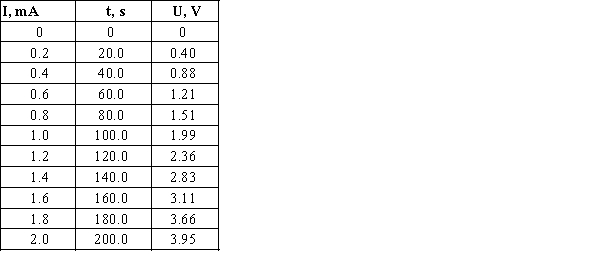To confirm Ohm's law, the student measures the voltage versus current for the conductor sample. The student changes the current through the conductor from 0 to 2 mA every 20 seconds increasing the current by 0.2 mA and measures the corresponding voltage value. The results of these measurements are presented in the table below.  Find the correlation coefficients for the obtained data and make your conclusions about thestatistical relationships between current and voltage and between time and voltage. Can we conclude that correlations imply causation for these pairs of variables?
Find the correlation coefficients for the obtained data and make your conclusions about thestatistical relationships between current and voltage and between time and voltage. Can we conclude that correlations imply causation for these pairs of variables?
A) Both correlation coefficients are very close to 1, so the relationships are very strong.Both of these relationships imply causation.
B) Both correlation coefficients are very close to 1, so the relationships are very strong.The change of current causes the change of voltage, but the change of time without changing current does not cause the change of voltage.
C) Both correlation coefficients are very close to 1, so the relationships are weak.The change of current can cause the change of voltage, but the change of time without changing current does not cause the change of voltage.
D) Both correlation coefficients are very close to 1, so the relationships are weak.Both current and time do not imply on the voltage of the conductor sample.
Correct Answer:
Verified
Q53: Exhibit 4-7
Golden-rumped elephant shrews have long flexible
Q54: One of the problems when estimating the
Q55: Exhibit 4-7
Golden-rumped elephant shrews have long flexible
Q56: Exhibit 4-5
During the first 3 centuries AD,
Q57: Exhibit 4-4:
Biological theory suggests that the relationship
Q59: As early as 3 years of age,
Q60: Exhibit 4-7
Golden-rumped elephant shrews have long flexible
Q61: For the given scatterplot, identify if there
Q62: Identify linear patterns in the scatterplots shown.
A)
Q63: According to the information of the Council
Unlock this Answer For Free Now!
View this answer and more for free by performing one of the following actions

Scan the QR code to install the App and get 2 free unlocks

Unlock quizzes for free by uploading documents